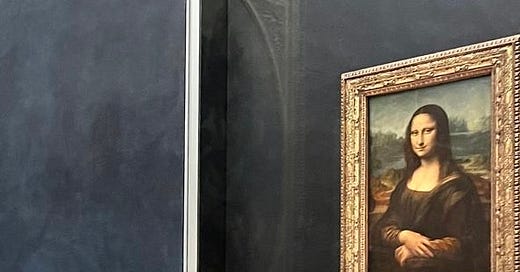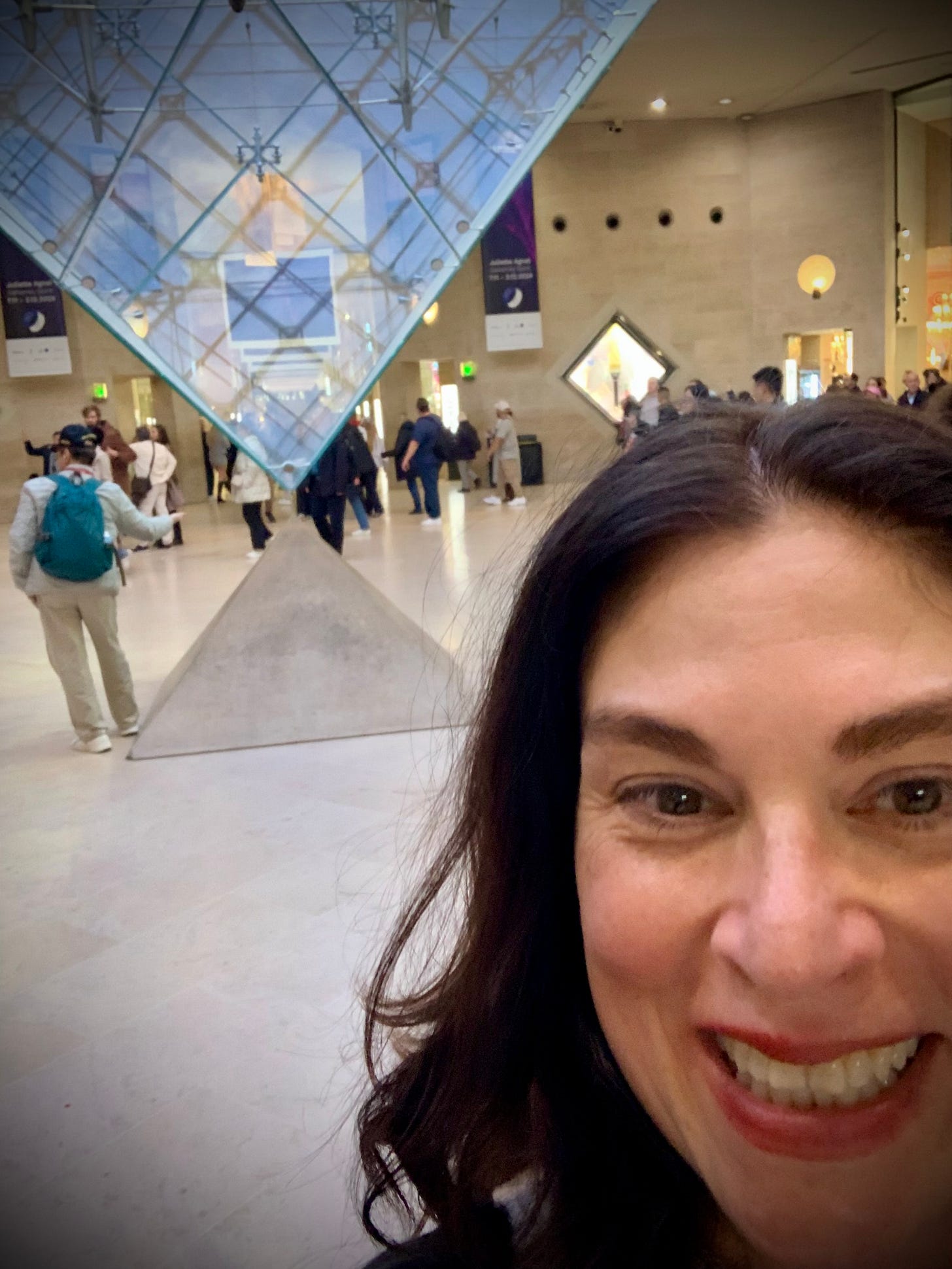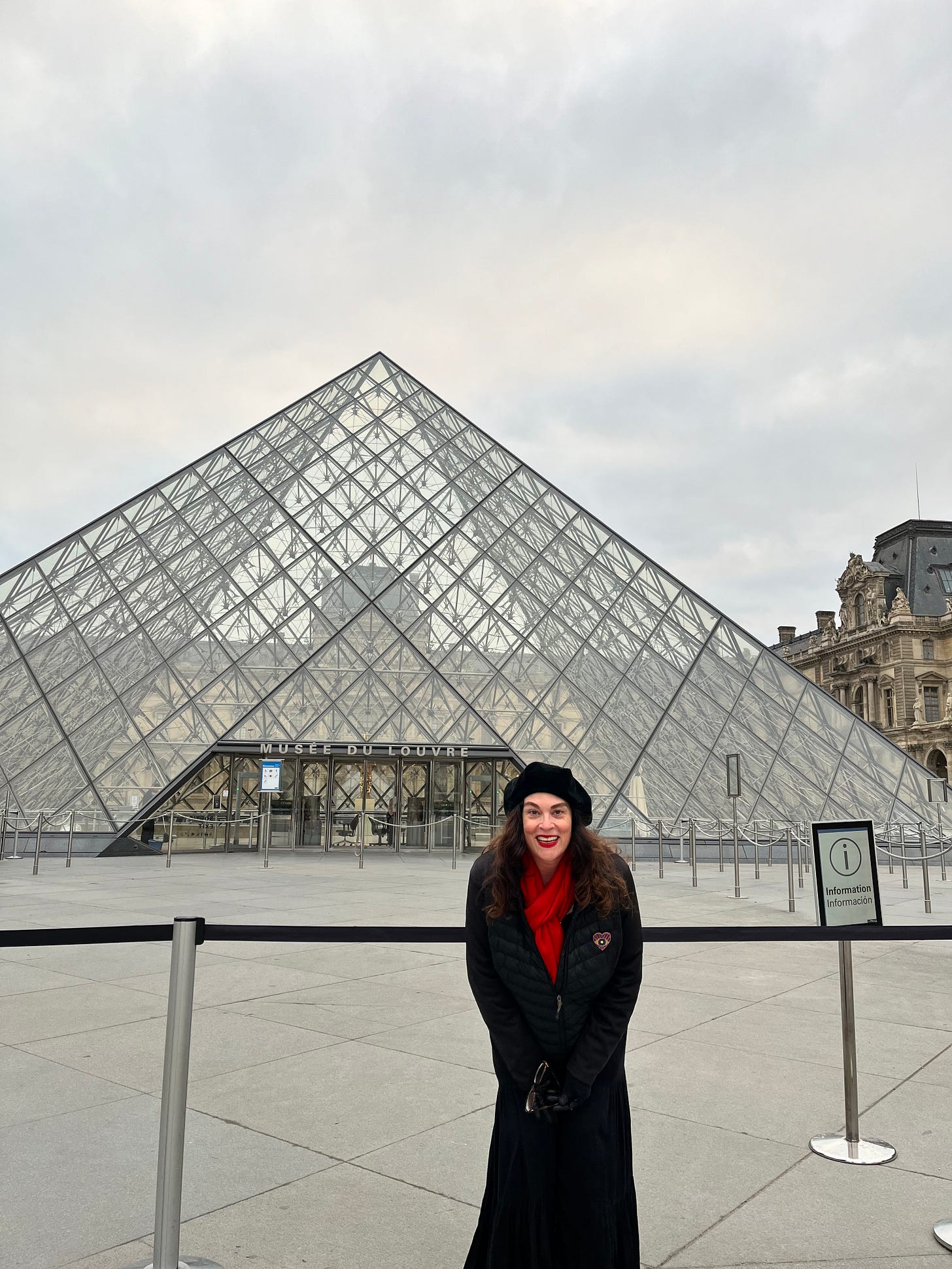When you have POTS, Postural Orthostatic Tachycardia Syndrome, you can go from the-bucket-list-dream-you-never-knew-you-had-until-you-did of dancing with a group of strangers in the streets at Place Colette in Paris, to having to use a wheelchair at the Louvre because standing too long in one place pools your blood to your feet until you realize you are no longer capable of wickedly defying gravity; instead, you’re testing gravity by passing out from syncope.
This leads me to the zen parable, The Farmer. It tells the story of how something bad can happen from something good and something good can happen from something bad. I was so excited about seeing the Louvre that each time we passed it, we took pictures in front of it (something good); but when we finally got to the Mona Lisa, this woman I had waited my whole life to see, the crowd clamored in front of the wheelchair blocking any access (something bad). When you’re in a wheelchair, your eyes are no longer level with the art, but rather a sea of asses (often both literal and figurative—our society still has a long way to go to accommodate disability mobility). A kind docent saw me struggling with the wheelchair, to get a glimpse of our gallery gal through all the thoughtless torrid tushies in the way, and broke through the crowd to let me come to the front and have an unencumbered view (something good). The impact was unexpectedly profound.
The Mona Lisa has been referred to as the most famous painting in the world; and I never understood why, until I saw it face-to-face. As a child, it was heralded as a spectacle one must seen in person in order to truly understand its fame. As an adult, I repeatedly heard people say it was a small, overrated portrait only famous for being famous.
Granma Used to Say, “It Takes One to Know One”
While far, far from ever being a Leonardo da Vinci, I am an artist, and art moves me deeply. My family and I are are part of an artist collective, SoulJourners, in which we fuse art with activism to educate, inspire, and enlighten, with a special emphasis on ending homelessness by following in Finland’s successful “Housing First” footsteps. We were in France as an extension of having been artists-in-residence at the highest rated and one of the top 10 most beautiful residencies in the world, Chateau d’Orquevaux. Being a family of artists ourselves, we consume and create art daily (primarily music, prose, performance, and filmmaking). It’s our blood type and quite simply, something we require for the survival of our nature. In other words, we revere art and artists with the highest regard. Museums and the breathing in of art are a staple in our lives, not a tourist trap or photo opportunity but an experience of communion.
When we rolled up in front of the Mona Lisa, it took our breath away. Without having to peer around bobbing bodies in a sea of iPhones posing for selfies with the Divine M, I was rendered into focused stillness with an immediate aching in my eyes, which began to fill with tears. It was personal, this moment with Madame Lisa. It was familiar. It was akin to meeting a pen pal in person for the first time, after 50 years of correspondence. I felt like I knew her, this being, this spirit, this entity on display beneath bulletproof glass. As if looking at primates in the zoo, I wanted at once to free her from captivity and yet keep her safely preserved for all to see, to know, and to love. It took decades to make this dream come true, yet we were only allowed seconds to view her. Not to mention the fact that I’d like to know her beauty secrets. After all, she’s over 500 years old and has never been fully restored and there’s not a single wrinkle on her lovely painted face. Maybe she’s well preserved due to the fact that she’s kept in a climate-controlled enclosure. Imagine if we all were. (Hello planet earth, I’m talking to you.)
My husband had a similar experience stating, “It was more powerful to see the Mona Lisa in person than looking at pictures of the painting. It seemed as if the Mona Lisa were alive and smiling knowingly at me. I had the sensation that we were sharing a deep connection in that minute or so that I was directly in front of her.”
Why do some people have little to no emotional response to her and others, like myself, feel positively changed by the experience? If I could tell you that, I might be able to solve all the problems of the world, for every chasm in communication breaks down to personal perspective, which we cannot control in another (although political propaganda and media manipulation have done an impressive and terrifying job controlling social purview; but I digress, per usual). The only clue I can share as to why I was so touched by this art is that I approach life with as much curiosity and presence as possible and do my best to leave judgment, bigotry, and preconceived ideas in a side bag attached to my hip labeled “Imperfect human characteristics I inherited and cannot completely free myself from, but I can at least be mindful of.” Note to self: work on a shorter label for that hip bag.
Why is the Painting So Famous?
It’s my understanding that most fame comes from intrigue surrounding controversy and or mystery, and sometimes, even talent; the Mona Lisa has all these components. It’s an Italian Renaissance masterpiece by Leonardo da Vinci. He was considered a genius, a polymath—quite literally, “a renaissance man.” He is commonly known for his three most famous paintings: the Last Supper, Vitruvian Man, and the work of art that is quoted as being the most famous painting in the world, the Mona Lisa. Part of the fame comes from the allure of not knowing the identity of the model in this famous painting.
Who is Mona Lisa?
Mona, in Italian, is a polite form of Mrs. or Madam. Lisa is the presumed name of the subject; ergo, Mrs. Lisa or Madam Lisa becomes Mona Lisa. Scholars assert the painting depicts Lisa Gherardini, the wife of Francesco del Giocondo, a Florentine merchant who commissioned the painting. Others believe it is a portrait of Leonardo da Vinci himself, as a woman. Freud, of course, declared the smile of the Mona Lisa must have been that of Leonardo’s approving mother. Oy! Everything with Freud comes back to the mother.
Theft
The painting really began to become famous after it was stolen in 1911 by, Vincenzo Peruggia, a patriot employee of the Louvre who believed the work of art belonged to Italy, not France. Would we call that “cultural appropriation colonization” if it were done today? As much as I love France and respect the Louvre, I think Peruggia had a fair point worth considering. The painting was done by an Italian, for an Italian, in Italy, so why is it housed in France? Has not a precedent for returning art to its homeland been set with other museums? But then again, Leonardo spent the last few years of his life working in France where he lived and died. He was loyal to his nurturer. France became his second homeland. Our nationality is not always the same as our ethnicity or origins; it is a mutable aspect of our identity that is within our control to change. Nevertheless, the theft gave the painting international exposure, which lead to its place in pop culture. One way to create an interest in something is to take it away—at least temporarily. A sense of scarcity can create an obsessive desire. Case in point: the Mona Lisa is a pop culture icon. Not only have songs and poems been written about her; but as a work of art, it has been reproduced hundreds of times and used in advertisements thousands of times.
Artistic technique
Finally, it is famous for the artistic technique used to create it. At 30 inches tall by 20 inches wide, the Mona Lisa is an oil painting on wood. It was created over several years during the 16th century (early to teen 1500s). There are no visible brush strokes in the Mona Lisa. Leo (if I may be so informal) painted in layer upon layer and used the art technique of sfumato, smoky or blurred gradations of color that blend so well they essentially remove lines. In fact, he used 30 different layers of painted glaze so thin that they only total half the width of a human hair. This creates what’s known as “The Mona Lisa Illusion” a changing appearance depending on where one stands in the room to view Lady Lisa, and/or the feeling that her eyes are looking right at you.
I wish The Louvre allowed appointments with a seated bench for at least 15 minutes of viewing for those of us who are actually interested in the art and not just the hype. I can’t promise that you will be as enamored with her as I am, but perhaps knowing a bit of the history will at least make the experience more rewarding. Walter Pater, wrote of the Mona Lisa, that she, “has been dead many times and learned the secrets of the grave,” to which I feel compelled to add, through every lifetime and recent reincarnation, the Mona Lisa has been a constant. She is a tour guide to ever-changing humanity, a time traveling sister, the gatekeeper to the world of art and mercurial fame; she is a friend.
Sage Justice is an award-winning playwright and critically acclaimed performing artist who has appeared on stages from Madison Square Garden in New York City, to The Comedy Store in Hollywood, California. Ms. Justice is the author of Sage Words FREEDOM Book One, an activist, a member of the Screen Actors Guild and an alumna Artist-In-Residence of Chateau Orquevaux, France. Sage is intensely sincere. Balancing wisdom and humor she most often writes deeply personal solution based pieces about the enduring virtues that connect us all: love and healing. She has a series of short reels about living with the rare genetic disorder, Vascular Ehlers-Danlos Syndrome that you can find in a highlight reel on her Instagram page @SageWords2027.







Also, ordered your book! 😊
Oh, how amazing it would be to study at the Sorbonne! I hope she gets to do that!
Have not made it to Scotland yet, but hope to in the near future. My children are all Irish citizens so a return to Ireland permanently is a hopeful possibility for us!! I definitely feel Paris isn't finished for me. I would love to return as soon as possible. If your daughter has never been to 59 Rivoli, I highly recommend it. What an inspiration! My son held his own with basic language (he has been learning Japanese for two years). The scams, well, he was quite frustrated and a bit intimidated, but as I was born and raised in Chicago, he got a quick education on how to handle them. 😉